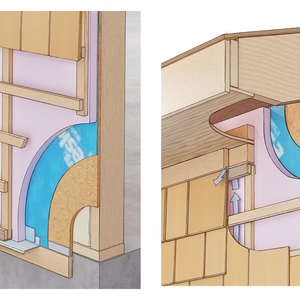Hey guys,
I consider myself a pretty knowledgable DIY type but I do not understand something. I have been reading in the FHB back pages and other publications about “systems” to keep water from getting trapped behind brick veneer walls. My question is, what is different now days compared to a house built in the 1950’s ?? My parents house was built in 1956. It is an all brick rambler with a full basement in the Washington DC area. I never remember them having any type of problems with water, mold etc. My mother lived in the house until she passed away in 1982, and there was never a problem with water in the basement, etc etc etc. I do not remember seeing any weep holes or other means to drain water from behind the brick.
I am asking this question because I am about to have a new home built, and would like it to be all brick. Is there something different about the way we are building brick houses in 2002 compared to 1956, or is it just a bunch of marketing “hype”
Thanks for educating me,
Bill
Discussion Forum
Discussion Forum
Up Next
Video Shorts
Featured Story

Tips for picking the right paintbrush based on paint type, surface, and personal comfort.
Featured Video
Video: Build a Fireplace, Brick by BrickHighlights
"I have learned so much thanks to the searchable articles on the FHB website. I can confidently say that I expect to be a life-long subscriber." - M.K.
Fine Homebuilding Magazine
- Home Group
- Antique Trader
- Arts & Crafts Homes
- Bank Note Reporter
- Cabin Life
- Cuisine at Home
- Fine Gardening
- Fine Woodworking
- Green Building Advisor
- Garden Gate
- Horticulture
- Keep Craft Alive
- Log Home Living
- Military Trader/Vehicles
- Numismatic News
- Numismaster
- Old Cars Weekly
- Old House Journal
- Period Homes
- Popular Woodworking
- Script
- ShopNotes
- Sports Collectors Digest
- Threads
- Timber Home Living
- Traditional Building
- Woodsmith
- World Coin News
- Writer's Digest


















Replies
In the past, the load bearing walls of a brick house were made of brick, two or more layers thick. Today a brick house is nearly always a frame house with a single layer of brick, called a brick veneer, applied to the outside. The Brick Industry Association Technical Note 7 (at http://www.bia.org/html/frmset_thnt.htm ) explains that, "These [older] masonry walls, both because of their thickness and their being in constant compression due to the structural loads, worked quite well in keeping water out of the interior of the building. Many older masonry walls were built with cornices and other ornamentation which helped to protect the faces of the buildings from excessive water rundown and subsequent water penetration to the interior." It then goes on to explain why the newer style brick veneer does not exclude water as effectively, and thus why there is a requirement for the waterproofing "systems" you referred to.
The reason for the change from solid brick walls to brick veneer on frame walls was economic. In the post-WWII building boom, it became fabulously expensive to build solid brick houses, and the demand for them evaporated.
Your parents' house may have been brick veneer. I'm no building historian, but '56 seems a little late to me for a solid brick house. If so, apparently it was competently detailed by a builder whose "system" just didn't happen to include weep holes. My brick veneer house was built in '64, also without weep holes, and I've seen no sign of water damage since I bought it in 1988.
Edited 8/18/2002 11:42:43 PM ET by Uncle Dunc
Just because you don't see weep holes doesn't necessarily mean they are not there. Rather than holes, or raked out vertical joints, there is a good chance that the mason used a wicking material. Look closely and you might notice some fat string at intervals. When the joints were struck the process usually obscured the wicks.
You roused my curiosity, so I got my scratch awl and went outside to take a look. There is a membrane flashing visible in places, but no weep holes that I could detect.
The only time we get wind blown rain here (Boulder, CO) is in thunderstorms. It seldom lasts 10 minutes, and very rarely happens on consecutive days, so my guess is that very little water ever gets behind the bricks. If I were building today, I would certainly add the weep holes. Climate patterns do change, and it would be cheap insurance.
Bill
For 10 years we lived in an all brick house in Bethesda, MD (near Washington DC), and I initially worried about water (from some of the East Coast Hurricanes that came through) getting in behind the double layer of bricks. But here's how it worked....any seepage through the bricks hit the inner layer of cinder blocks and ran down to the basement wall 8" cinder blocks and once inside of them, down to drain tile along the footings. While we lived there, we found that some of the basement wall cinder block 'columns' would fill with water and then seep out onto the basement walls, probably due to a clogging of the late 1940's drain tiles. So I dug a French drain, routed it to a sump and a pump took care of that.
I agree with the above poster that such a house built today would be quite expensive.
BruceM
Bill,
There can be some differences.
Overhangs; 50's ramblers genrally have large overhangs so less moisture gets to the wall in the first place.
Second, they were less lilely to screw up flashing. The building boom of the last 30 +/- years has lead to some pretty uninformed practices taking hold in some area of the industry. (Keep in mind that this is the Fine Homebuilding site, the folks who hang pout here are aself-selecting group of fine homebuilders!)
Houses are built much tighter today, so moisture that gets in tends to saty in a lot longer, giving mold a much better chance to get started and to spread significantly.
would like it to be all brick
You mean brick veneer all all 4 (or whatever) sides, right? I doubt if any structural brick houses are being built today.
Edited 8/19/2002 4:51:32 PM ET by Bob Walker
Quite a few of the 50's brick houses were actually block houses with brick veneer. Most of these nasty molds need cellulose (wood) and they were far from being tight construction.
Thanks for the education guys. I think I have some pictures somewhere of my parents house under construction. I am fairly certain that it was not block with brick over top, but I am not 100% sure. The house I am planning will be brick veneer on all four sides. I am hoping it will be the last one I build, and want it to last and be as low maintainance as practicle.